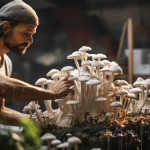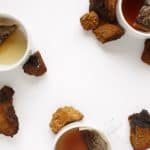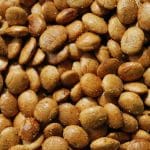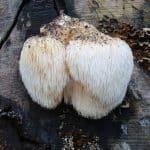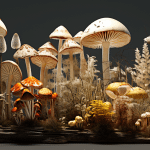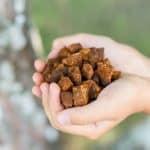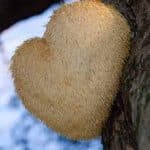Besides choosing a substrate to use, deciding when is an appropriate time to either pasteurize or sterilize a material is another crucial part of learning to create fungi substrates. Some people have extremely elaborate mushroom growing setups, which include a negative-air-pressure cleaning room with expensive equipment. However, we found this makes the process much more complex than it needs to be, with no meaningful benefits.
So, we opted for the low-tech growing style. But you will need to learn how to pasteurize mushroom substrate as well.
We have found that if you follow the basic procedures of sterilizing or pasteurizing the mushroom substrate, there is a very small possibility of infection. Keeping surfaces clean and wiping with 70% Isopropyl Alcohol when you are inoculating them are enough for most growers.
What is the difference between pasteurizing vs. sterilizing a substrate
Both pasteurizing and sterilizing your substrate involves heating your substrate to try and kill existing bacteria or fungi, but pasteurization heats your substrate up to 185 degrees Fahrenheit, whereas sterilization puts your substrate into temperatures above 250 degrees Fahrenheit. Keep reading for a closer look at the differences.
Learn more: How to grow mushrooms in your backyard
Different Ways to Pasteurize Mushroom Substrate
The point of pasteurization is to make your substrate as contaminate-free as possible, and give whatever mushroom cultures you are introducing a nice start.
Hot Water Bath Pasteurization
One way of pasteurizing your substrate is to just soak it in boiling water for at least one to two hours. For most operations, we found pasteurization was enough to allow mushrooms to be grown with a minimum of contamination.
Cold Water Lime Pasteurization
To perform this method, immerse the substrate in a hydrated, lime-treated, Hot-water bath for 24 hours. This increases the pH of the water, killing contaminants in the process.
How to Sterilize Mushroom Substrate
Sterilization involves exposure of a substrate to temperatures above 250degF, as well as placing the substrate under pressure. Sterilization is intended to remove all contaminants which may exist on the substrate, whether living or presently dormant. Simply boiling a substrate does not heat it sufficiently enough for complete sterilization.
A pressure cooker or similar device is needed to fully sterilize.
Learn more: How to preserve mushrooms
Sterilize Mushroom Substrate Without a Pressure Cooker
There are several ways that you can sterilize your media without using a pressure cooker. A process called tyndallization, or fractional sterilization, may be used as well.
This is accomplished by boiling cans or bags for a specified amount of time, for a number of days at a time. The goal is to kill off both any microbes currently present in the medium and also any spores which might need several days to start growing. Anything that brings the substrate over 250degF for a long time will likely be sterilizing. This includes placing your substrate into a furnace, oven, or autoclave.
The problem with this, though, is that it will bake your substrate, completely drying it. Some substrates can even begin to burn. If you sterilize your substrate like this, you will have to rehydrate it with distilled water afterwards, but keep it sterile all the same.
Why is pasteurization or sterilization necessary?
Pasteurization or sterilization removes molds and bacteria, and helps to make sure the mycelium you are trying to grow will have the best possible chance of becoming established.
The soils and substrates in which mushrooms prefer to grow are extremely moist and rich in nutrients. While this is the perfect environment for mushrooms, it is also an ideal condition for other things, such as molds and bacteria, to grow. Bacteria and molds can grow more quickly than the mycelium of mushrooms.
If left to their own devices, these contaminants outcompete the mycelium, taking over the substrate before the mushrooms can have a chance to become established, most of the time. So, we have to do something to give mushrooms a little bit of an early head-start and make sure that they are able to colonize the substrate before the other forms of molds or fungi are able to.
Pasteurizing the mushroom growing substrate is equivalent to pulling out all the weeds in the garden as early as possible before planting vegetables. Sterilizing is more akin to burning down the soil and killing all of the living plants and seeds within.
Do You Have to Sterilize Mushroom Substrate Or Can You Skip This Process?
For certain varieties of mushroom substrates, sterilization is essential for contamination prevention. For other types of substrate, you can get away with just pasteurizing. The biggest factor for determining if you should sterilize or pasteurize is the nutritional content of your substrate. Manure is the perfect example of a substrate that always needs to be sterilized.
By its very nature, it is already full of bacteria and microbes. It may not sound like an alluring habitat, but because it is made from partially digested foods, it makes for a simple source of nourishment for a variety of different life forms.
Any material on the substrate that might be considered a food must be sterilized for a similar reason. This includes rye grains, popcorn, brown rice, and wheat berries. These substrates are rich in nutrients, and they are loved by a variety of different fungi and moulds. You may have observed yourself in your own kitchen as mold starts growing on foods just after one to two weeks.
High-nutrient substrates must be sterilized in order for mushrooms that you are growing to get off to a good start. Less-nutrient substrates may be pasteurized rather than sterilized. A great example of this is straw. Straw is the dried stems from different grains plants, after they remove all of their grains.
While it still has some nutrients left, it is not nearly as nutritious as grains themselves. Coco coir, wood, and cardboard are similarly receptacle-free. Pasteurization is sufficient to eliminate the bulk of the mushroom competition, giving you an advantage. If you encounter a new substrate we have not discussed here, simply ask yourself one question to determine whether this is the kind of material you need to pasteurize or sterilize.
Is this something a wildlife animal would eat?
Things like vermiculite and straw are not appealing food sources to most animals, and they are certainly not appealing to rodents. Meanwhile, animals, and humans, will eat grains, as they are packed with nutrients.
One thing to be careful of is mixing the substrates, otherwise known as augmentations. You can add a more nutrient-dense substrate into another one, making the whole thing nutrient-dense. For example, adding dung to hardwood wood chips.
Woody pellets or sawdust usually do not have to be sterilized. But as soon as you add in other materials that makes it easier for molds or bacteria to grow, you’ll need sterilization. If in any doubt, you can sterilize any of your media for added safety. It just requires some additional work and equipment.
Fermenting Straw Instead of Pasteurizing
One thing that mushroom farmers can do rather than pasteurize their straw is ferment it. This involves submerging a bag filled with straw under water for around a week. If you are fermenting an entire bale of straw, you probably will have to soak it longer, for about two weeks. During that time, the straw starts breaking down (fermenting) with the help of anaerobic organisms.
These are types of bacteria that can survive in oxygen-free environments alone. As a result, any other organisms that would normally need oxygen to survive are killed. Once wet straw is discharged, exposed again to the air, all anaerobic organisms are killed off, and straw is basically pasteurized. One of the reasons that we choose to pasteurize rather than ferment is because the technique smells pretty much like rotting garbage.
Think of the process for fermenting foods such as sauerkraut, kimchi, or kombucha. It is essentially the same process, but it involves straw. If using this method, you will want to avoid getting any of the water onto your hands or clothes. The odor is really hard to remove.
The other disadvantage to fermenting rather than pasteurizing is the time and planning required. When you are fermenting, you have to anticipate that the necessary substrates are going to come in at a time that is one week or longer in advance. If you are pasteurizing, your substrate may be ready for use within hours.







